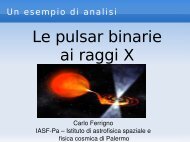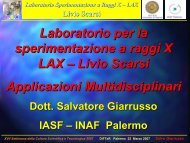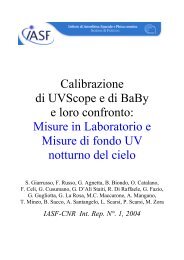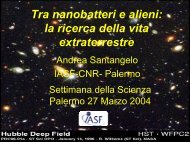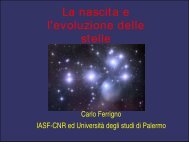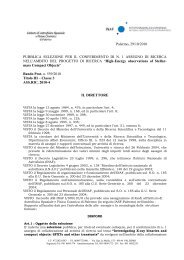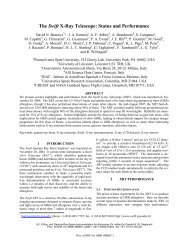GRB 050223 and GRB 050911 - IASF Palermo - Inaf
GRB 050223 and GRB 050911 - IASF Palermo - Inaf
GRB 050223 and GRB 050911 - IASF Palermo - Inaf
Create successful ePaper yourself
Turn your PDF publications into a flip-book with our unique Google optimized e-Paper software.
seconds. Although T 90 > 2 s for <strong>GRB</strong> <strong>050911</strong>, there are two initial short (∼ 0.5 s) spikes.<br />
Thus, <strong>GRB</strong> <strong>050911</strong> is like many short bursts in showing an initial short peak followed<br />
by longer, softer faint high energy emission (Lazzati, Ramirez-Ruiz & Ghisellini 2001;<br />
Connaughton 2002; Norris & Bonnell 2005). Simulations show that the later peak would<br />
not have been detected by BATSE at greater than the 1σ level; therefore, if BATSE had<br />
triggered on this weak burst at all, it is likely that it would have been classed as short.<br />
<strong>GRB</strong> <strong>050911</strong> could, therefore, have been caused by a merger event: if one of the<br />
compact objects were a black hole, rather than a neutron star, the large mass ratio could<br />
lead to delayed accretion <strong>and</strong>, hence, high energy emission after 2 s (Davies, Levan &<br />
King 2005). See Page et al. (2005b) for more details.<br />
CONCLUSIONS<br />
The X-ray afterglows of both <strong>GRB</strong> <strong>050223</strong> <strong>and</strong> <strong>GRB</strong> <strong>050911</strong> are among the faintest<br />
observed at early times. Although Swift has the ability to measure faint X-ray emission<br />
out to many days after the burst, some afterglows are still too weak to be detected,<br />
indicating a difference in environment <strong>and</strong>/or formation mechanism.<br />
REFERENCES<br />
1. S. Barthelmy et al., 2005, Nature Letters, in press<br />
2. A.P. Beardmore, K.L. Page., N. Gehrels, J. Greiner, J. Kennea, J. Nousek, J.P. Osborne,<br />
G. Tagliaferri, 2005, GCN4043<br />
3. V. Connaughton, 2002, ApJ, 567, 1028<br />
4. M.B. Davies, A.J. Levan & A.R. King, 2005, MNRAS, 356, 54<br />
5. D.B. Fox, C. Pagani, L. Angelini, D.N. Burrows, J.P. Osborne & V. La Parola, 2005a,<br />
GCN 3956<br />
6. D.B. Fox et al., 2005b, in prep.<br />
7. N. Gehrels et al., 2005, ApJ, 611, 1005<br />
8. O. Godet et al., 2005, A&A, in press<br />
9. S.T. Holl<strong>and</strong> et al., 2005, GCN 4034<br />
10. D. Lazzati, E. Ramirez-Ruiz, G. Ghisellini, 2001, A&A, 379, L39<br />
11. T. Mineo et al., 2005, GCN4188<br />
12. J.P. Norris & J.T. Bonnell, 2005, ApJ, submitted<br />
13. J.A. Nousek at al., 2005, ApJ, submitted (astro-ph/0508332)<br />
14. C. Pagani, V. La Parola, & D.N. Burrows, 2005, GCN3934<br />
15. K.L. Page et al., 2005a, MNRAS, 363, L76<br />
16. K.L. Page et al., 2005b, ApJL, in press (astro-ph/0512358)<br />
17. L. Piro, 2004, ASP Conference Series, Vol. 312, in press (astro-ph/0402638)<br />
18. B. Zhang & P. Mészáros, 2004, Int.J.Mod.Phys, 19, 2385



